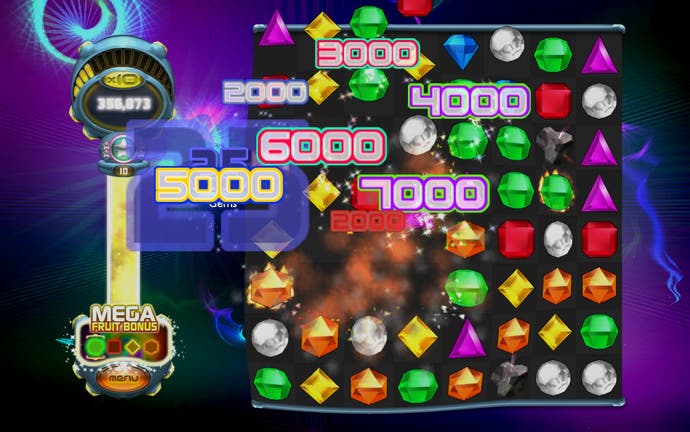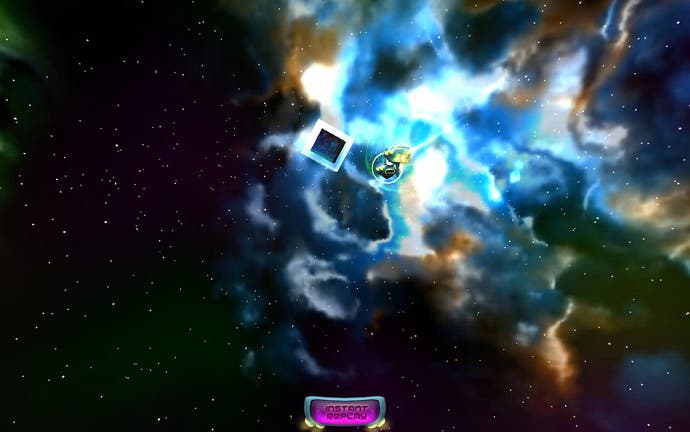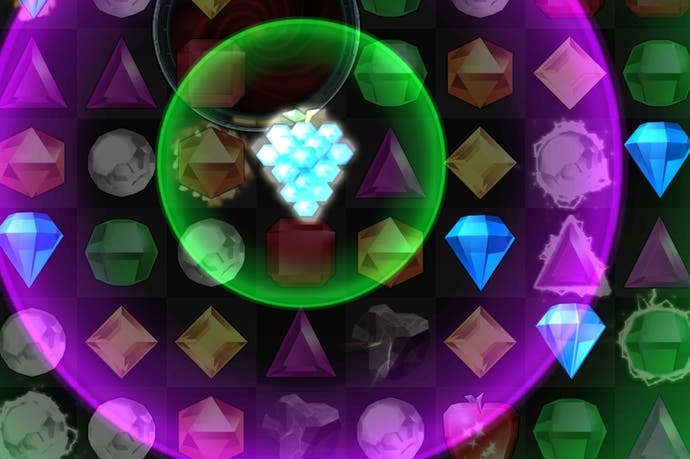Bejeweled Twist retrospective
Vive la revolution.
In 2008 - before the crash - PopCap launched Bejeweled Twist with a party in the Sky Church at Seattle's Experience Music Project venue. Gymnasts played human match-three in the wonky, Gehry-rigged lintels, and waiters in retro-future Jetsons outfits wandered about serving cocktails. Earlier that day, I'd had a chat with the company founders back at their huge HQ just down the road. They'd shown me an early build of another new game, and it was one they seemed to be ever so slightly nervous about. A zombified spin on the tower defence genre, they knew it was clever, but they sensed it was potentially a little too hardcore, a little too niche to become another cash cow. Pre-lawyering, it was called Lawn of the Dead.
No worries, though, right? Whatever happened, they had a guaranteed million-seller on their hands, and another game that should at least go on to be an entertaining curio. Typically, as it happens, the PopCap founders were correct. Less typically, they had gotten the specifics muddled up. The tower defence offering was one simple name-change away from video game legend. Twist, meanwhile, would prove considerably more problematic.
Somewhere in my mind, I have Bejeweled Twist filed as a bit of a botch. It sold well enough, I gather, but I don't get the impression it connected with its audience as obviously as Bejeweled 2 had - and by the time Bejeweled 3 came along, the alterations that Twist made to the basic formula were nowhere to be seen. Crucially, I can't remember really playing Twist that much beyond a few turns at the EMP, so earlier this week I thought I'd give it another five minutes as a reminder of why I didn't like it, and then I'd get on with my life, an older and wiser engine.

Ten hours later, I looked up from my screen, stared cloudy-eyed past the hunched form of the office cleaner, and realised things were probably a bit more complicated than I initially thought. Twist isn't a bad game at all. It just doesn't feel like a PopCap game - and that's fascinating in itself.
What's strangest, looking back, is that Twist feels like a product of over-thinking things. There's been a lot of energy expended on the big stuff, like the gem-turning mechanic that now takes centre-stage, and on the little stuff, too, such as the way the UI transforms into a spaceship as you blast between levels, and appears to be using your progress bar as the fuel it needs to navigate interstellar space. Fiddly screen furniture is one of those weird elements I happen to love about games, the way that other people have a thing for airline food or infomercials. PopCap, however, normally tries to cut through the clutter, and it's a strategy that has probably served the company well.
Let's go back to the central change, though: while Twist retains the falling gems and the match-three goal of previous Bejeweled games, it completely transforms the way you interact with the board. It's closer to Hexic than previous entries in the series, in fact (although I'm sure I also saw a similar scheme used on an old Windows pack-in puzzler that predates Pajitnov). You now grasp at 2x2 groups of gems and rotate them clockwise to make matches. You're no longer batting away flies; you're fiddling with the tumbler on an old safe.
As with Hexic, this clockwise business slows the heart-rate of your typical gem-swapper and turns it into something a lot more complex and tactical. Most obviously, this is because you're moving a larger number of gems at once, which means you have more variables to take into account when making matches. To me, it also feels like you're using a different and slightly less reliable part of your brain: a part that deals with taking images and rotating them, rather than a part that simply slides pieces of a picture left and right, up and down, in order to plan ahead.
Whatever's going on with your neural maps, years of perfectly good Bejeweled experience goes right out the window. I spent my first five minutes with Twist trying to come to terms with the fact that what I was really looking for as I scanned the grid was two matching gems touching horizontally, with another matching gem underneath one of them. The objective had stayed the same, but I was learning to hunt for new shapes - and this kind of learning takes time.

Moving multiple gems at once seems to make it a lot harder to intentionally cause chain reactions when you're getting started. Speaking of chains, it's only appropriate that Twist turns out to be a pretty good case study in how one design decision can impact everything else in a game. You can rotate gems without making a match each time here - an empty turn merely eats into your growing multiplier. This means that you have an unprecedented level of control over the layout of the entire board: you can fiddle to your heart's content. In turn, this control means that the original - and slightly unsatisfying - defeat condition of Bejeweled, where you suddenly find that you've run out of moves, no longer works, so PopCap's had to create a new threat to stop your game from lasting forever.
Enter bombs, promoted from the puzzle mode in Bejeweled 2, I think. Here, they're an addition that ultimately changes the basic formula even more than all that twisting business. Bombs appear with greater frequency as you work your way through the game - they're gems with countdown timers, essentially, and they give you a set number of turns to get rid of them before they blow. There's typical PopCap flair applied to all of this: the way they start to shake and vent steam as they tick away to themselves is a lovely bit of visual design, and your first few bombs give you a roulette spin before they go off, offering a chance - with the odds stacked heavily in your favour - to avoid defeat.
They still fundamentally transform the game, however, gradually turning a gem-matching hunt across the entire board into something with a little more tension and a little more tactical bite. By the time you're hitting level 14 or 15, novice players are best off focusing exclusively on those bombs whenever they appear. You're no longer purely maximising your score, you're tackling a series of deadly threats - you're dealing with set-pieces, and with a game that actively wants to do you in.
Alongside the bombs, a handful of other special pieces have been added, which, taken as a whole, suggest that PopCap's designers were reacting to a certain loss of immediacy in the game - a vacuum created by the increased difficulty in pulling off the really big matches, perhaps. Coal gems join bombs in making the transition from that puzzle mode - they're unmatchable pieces that need to be blown to bits with special moves. Then there are locked gems and even doom gems - bombs that tick down with each wasted turn.

When you're not fire-fighting all of that, the true long-term challenge of the game lies with various meters and objectives placed on top of the gem-matching itself. You earn treats for matching gems in specific sequences, and you also build a multiplier with each contiguous match. String matches together long enough and you start to swap gems out for fruit - massively potent variants that will not only send your score through the roof when used but will also reset the timers on any nearby bombs. All of a sudden, you've got conscious game-changing choices in the middle of your regular - and mostly unconscious - moment-to-moment Bejeweling. Deal with a bomb now and risk breaking your multiplier, or ignore the bomb and hope the multiplier turns it into fruit before it has time to go off?
Twist's brilliant fun, then - it's just not particularly easy to get to grips with. It's not about playing the board so much as it's about understanding how the board interacts with a variety of other scoring opportunities. Step away from misleading terminology like casual and hardcore and the issue's clear: PopCap's taken a game of instant and fairly obvious pleasures and turned it into something a lot more complex.
Did PopCap learn much from Twist? Almost certainly. Bejeweled 3 offered plenty of clever variations on the basic formula, but it took care to mount them around a very familiar standard mode, while the whole rotation mechanic arguably found its real home - if not the sales it deserved - in Gyromancer. This wonderfully weird puzzle-RPG collaboration with Square Enix is a bit cumbersome in the main, but there's a glorious and energising elegance to the way that your wasted turns become your enemy's attacks during gem-matching battles.
Rather than draft in cheating AI - and all AI feels like cheating AI in puzzle-RPGs, I'd argue - you're fighting against your own mistakes in Gyromancer. As for Bejeweled itself, PopCap found that continued relevance ultimately meant cleaving deeper to that match-three immediacy rather than stepping back from it. It lives on most vibrantly in Blitz these days, slapped on iOS and Facebook and stripped down to a minute or so of coloured lights and potent room-dissolving focus.
Even so, that Sky Church launch party can seem like the last time PopCap truly felt confident. I met the founders again shortly after the release of Plants vs. Zombies, and they openly admitted that they were a little shaken by its success with the Steam audience, just as they were shaken by Peggle's success with PC gamers - and Twist's slight miss with their traditional fans. Recent years have seen a sale to EA, the migration of the company's core audience to smartphones by way of a dalliance with social networks, and a glut of hidden-object games.
The weirdest moment in a half-decade of PopCap-watching came a few weeks back at EA's E3 press conference, though. The lights dimmed, the screens flickered to life, and while Andrew Wilson paced backstage, presumably rehearsing his weird shtick about ball physics, cage-fighting and the inherent pleasures of being punched in the face, PopCap co-founder John Vechey walked out and announced that Plants vs. Zombies was being reborn as a third-person shooter. You know: with multiplayer. With character classes.
Squint and it's Bejeweled Twist all over again - but where are the gymnasts, and where are the cocktails?


